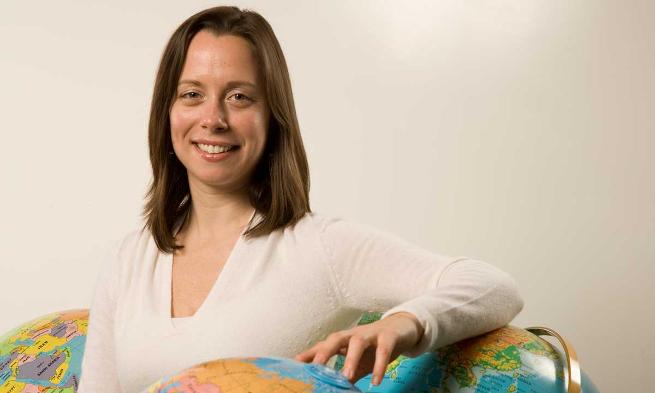Classroom in the frozen north
Being the Change
Alumna inspires her students from the Arctic's edge
By Barbara Finnegan ('05M, '03P)
Schneider teaches second grade in Arlington County, Va. Her school, Barrett Elementary, participates in NASA's program to bring innovative science and mathematics instruction to educators, students and their families. So when Schneider heard about Earthwatch Institute's 11-day expedition, Climate Change at the Arctic's Edge, she decided to apply for a grant to cover the cost of the trip. She won the experience of a lifetime.Julie Schneider ('99) knew her journey to the edge of the arctic would be a once-in-a-lifetime adventure, and a great way to liven up science lessons for her young students. But she had no idea that her entire community, including parents at her school and her circle of friends and acquaintances, would be fascinated and informed by her trek to study climate change in Canada's tundra and boreal forest.
On Feb. 28, 2009, Schneider headed for the tiny West Hudson Bay town of Churchill in Manitoba, Canada, to join the other members of her team. Her destination was the Churchill Northern Studies Centre about 30 miles outside of town. The center supports scientific researchers working on a diverse range of topics of interest to northern science. Schneider worked directly with scientists on their projects at the center. She helped gather data for research about the effect of climate change on spruce trees and various characteristics of snow in the center's snow pit. Data she gathered at the snow pit will be added to work that has been ongoing since 2001.
As part of Earthwatch's Live from the Field program, Schneider shared photos and her daily experiences through a blog, and conducted two videoconferences with her class back in Arlington. The English major and early childhood education minor spoke "face-to-face" with her students and others from her school for about 15 to 20 minutes, and explained to them what it was like to do scientific research. She also showed the students the various tools her team used for snow pit research. "They loved it," she says.
They also loved seeing pictures of their teacher helping to build a real igloo. Schneider opted to spend an uncomfortable, but memorable, night in the igloo, braving minus 20-degree Farenheit temperatures. On her blog, Schneider told her students about her experiences with two authentic modes of arctic transportation -- the dog sled and "qamatuk." She describes a qamatuk, which carried her team to the snow pit for research duties, as a "winter roller coaster ride across the snow and ice. We sit in a box with couch cushions and are pulled by a snowmobile. It can become bumpy and the wind whips across your face."
Schneider says the scientific method she observed during her expedition will help her in the classroom. "The scientific method is important in my teaching, and I learned so much more about science by working with the scientists and seeing science in action. It was wonderful." she says.
Schneider is excited about the material she's teaching her students. "I have more of an interest in science than ever before," she says. She plans to use some of her tundra pictures and videos when she presents lessons about how weather affects the earth and plant and animal habitats, and how plants and animals adapt to change. But it's her enthusiasm and love for the subject that's likely to inspire her students to keep learning all they can about the world around them.
Always interested in learning, Schneider says her experience has made her feel brave enough to try anything in life. She hopes to participate in another Earthwatch expedition. "One of my goals was to go and inspire my students," she says. "I think by seeing me work as a scientist for a few days, it helped them realize they have so many opportunities -- they can grow up and do anything."
Of course, the impact of Schneider's adventure has spread outside of her own classroom to school parents, fellow teachers and friends. How does that make her feel? "It makes me smile," she says.
See photos and read more about Julie Schneider's arctic expedition on her blog at http://www.earthwatch2.org/lff/schneider.
About the author
Barbara Finnegan ('05M, '03P) is the owner of LarsonHess Professional Writing Services, a marketing consultation and writing company. She earned a JMU M.B.A.
